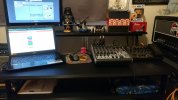snarf
making guitars wish they were still trees
Haven't really done much recording up until now, but want to start trying to get in on some of the fun down here in the basement. So I pulled out all my recording gear, added a little bit to it, and am trying to learn a new DAW. Put me an actual desk in my little music room, and I got everything all setup today. So I'm testing it out.
So this "for your review" isn't really about the playing. I was just jacking around testing the new setup. Those of you that have been doing this for a while, how does the mix sound? Is it about the right level? Is the guitar a sufficient level above the accompaniment? There are some fizzy parts about 30 seconds in. What did I do wrong there or did I just have my level too high? Any input will be appreciated.
Linky
So this "for your review" isn't really about the playing. I was just jacking around testing the new setup. Those of you that have been doing this for a while, how does the mix sound? Is it about the right level? Is the guitar a sufficient level above the accompaniment? There are some fizzy parts about 30 seconds in. What did I do wrong there or did I just have my level too high? Any input will be appreciated.
Linky



